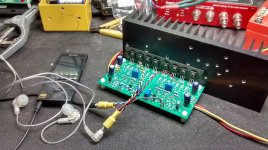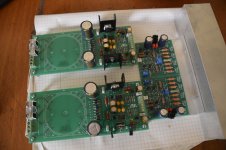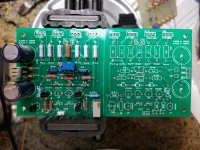BTW -- have you listened AS-IS to get a feel for the potential?
Put some 3.5mm jack sockets on the amp and had a quick listening test through my AKG K240 studio cans(flat response), the amp sounds very good, it's clear and has a lot of low effortless grunt.
Also tried some HiFiMan RE400(32 ohm) and MEE M6 Pro(16 ohm + flat response) earphones. Both sound very good with the amplifier, crystal clear and good natural bottom end.
Source was a Sony Walkman NW-A25 which also has a few Hi-Res albums in it.
Next I need to connect the amp to my E-MU 0202 usb sound card.
Still using the 2x 12V Yuasa lead acid batteries for power, all the transistors are running cool and there's no hiss or other noise at full volume from the Walkman.


Attachments
Hello Craigtone. How would you describe the sound and performance?
THx-Richard
I think it sounds great! I have always been a fan of the older receivers with headphone outputs that were simply series resistors off the main outs. This has more detail than any of those I have heard. Noise floor is very quiet! I have run this on Grado GH1's and Senn HD6xx with no problems.
I recently built the Pass Whammy and I must admit I like the musicality of the Pass only slightly better, but the noise floor of yours is much lower.
Next step is to play with my USB reference mic and miniDSP per your article to check frequency response and apply some filter correction between pre-amp and headphone amp just to compare the Grado and Senn and see if the scale really does "balance"
jackinnj,
Do you still have Marsh Headphone Amp PCB's and parts kits available to purchase?
Thanks
DT
Yes, the boards are $3 and provide for two channels. PM me.
I think it sounds great! I have always been a fan of the older receivers with headphone outputs that were simply series resistors off the main outs. This has more detail than any of those I have heard. Noise floor is very quiet! I have run this on Grado GH1's and Senn HD6xx with no problems.
I recently built the Pass Whammy and I must admit I like the musicality of the Pass only slightly better, but the noise floor of yours is much lower.
Next step is to play with my USB reference mic and miniDSP per your article to check frequency response and apply some filter correction between pre-amp and headphone amp just to compare the Grado and Senn and see if the scale really does "balance"
Thank you for the good input. The Pass Labs tend to have higher harmonics... esp 2H. You aren't alone ... many people like a little 2H added to the sound. I have tried to make the HPA as accurate as possible instead.
Next week-end i am going to Jam's house (he is designer of Pass Labs HPA) and listen to his system and I can also compare the two HPA -- mine and his. I already saw the THD data on the Pass Labs... so it will be an interesting listen.
-Richard
Last edited:
Yes, the boards are $3 and provide for two channels. PM me.
PM sent.
Waiting for transformers and believe it or not a small pillar drill for the heatsink work. My Dremel isn't quite up to it.
For this build I chose a pair of Sulzer Regulator boards from ATL:
PCB for modified Sulzer regulator – v.2 | ATL Hi-Fi Audio Company
Hopefully my calculations are good for around 20V rails.
Also hoping to snag a decent scope so I can show something meaningful other than pics of assembled boards! Possibly I'll just get a Velleman PC scope with function generator.
For this build I chose a pair of Sulzer Regulator boards from ATL:
PCB for modified Sulzer regulator – v.2 | ATL Hi-Fi Audio Company
Hopefully my calculations are good for around 20V rails.
Also hoping to snag a decent scope so I can show something meaningful other than pics of assembled boards! Possibly I'll just get a Velleman PC scope with function generator.
Attachments
Hello RNMarsh and Crew,
This afternoon I took the time to reread your Linear Audio HPA article. I read with particular interest the section on device matching.
I also took a relook at Keysight’s book, “The Parametric Measurement Handbook”, at the section on matching transistors. Without careful device matching there is greater DC offset and distortion.
In this thread you note that distortion performance improves even more with increased voltage and current.
As I was reading this stuff I was musing: at higher operating voltages will the devices shift away from the previously chosen neutral TempCo point? Or not so much? The test data says that DC offset remains stable even with increased operating voltage.
I usually play with tubes. I am a little nervous about vacuum tube voltages as I get a feel for using some new test equipment on my bench.
DT
This afternoon I took the time to reread your Linear Audio HPA article. I read with particular interest the section on device matching.
I also took a relook at Keysight’s book, “The Parametric Measurement Handbook”, at the section on matching transistors. Without careful device matching there is greater DC offset and distortion.
In this thread you note that distortion performance improves even more with increased voltage and current.
As I was reading this stuff I was musing: at higher operating voltages will the devices shift away from the previously chosen neutral TempCo point? Or not so much? The test data says that DC offset remains stable even with increased operating voltage.
I usually play with tubes. I am a little nervous about vacuum tube voltages as I get a feel for using some new test equipment on my bench.
DT
Thanks to TECH-DIY
Thanks to TECH-DIY,
Friday I received the HPA PCB and parts kit. Most of 1 side is fabricated. I did swap out the provided source resistors for the specified 51R1 value (dark blue Vishay RNC55 resistors in the photo) also the specified 249R resistors were swapped out (light blue Phillips RN55 resistors in the photo).
I also have received from Mouser some MJE 200 and MJE 210 transistors that will require matching. I have a Keysight B2962A SMU that records Volts and Amps, the software will plot curves and calculate parameters for matching.
Looking forward to mixing and matching and testing results.
DT
Thanks to TECH-DIY,
Friday I received the HPA PCB and parts kit. Most of 1 side is fabricated. I did swap out the provided source resistors for the specified 51R1 value (dark blue Vishay RNC55 resistors in the photo) also the specified 249R resistors were swapped out (light blue Phillips RN55 resistors in the photo).
I also have received from Mouser some MJE 200 and MJE 210 transistors that will require matching. I have a Keysight B2962A SMU that records Volts and Amps, the software will plot curves and calculate parameters for matching.
Looking forward to mixing and matching and testing results.
DT
Attachments
HiY'all,
This is my "me too" post. Received the boards and parts kit from DIY. So, for the Marsh Head Phone Amp[ (MHPA) my goal is to build two of these, one for me and one for my little girl.
That said, I'm now looking into chassis and PSUs etc.
I'm looking at Mark Johnson's RingNot which looks intriguing.
Also, another DIYAudio builder suggested that I use the AnTek AN-0212 - 25VA 12V Transformer. Okay I can see that. The transformer is different than MJs RingNot. So, I need to figure out how to modify it for use as a potential for the MHPA.
Then, that brings up another question and I asked Mark but not answered yet.
I assume then I'd have functional blocks as follows:
PSU ===> Salas 1.3shunt ===> MHPA
I'm not shure what else I'd need to do, but since I'm building the MHPA, I should post here so that other folks might benefit from my questions and build.
Or, do I just use a couple of Ti's evaluation boards (TPSYA47xxEVM-094 Evaluation Module): LINK
Here is link over in Power Supplies: LINK
Here is link over in YouTube: LINK
The latter is considered a Top 100 Guitarist by Rolling Stone.
Then there is this: LINK
This is my "me too" post. Received the boards and parts kit from DIY. So, for the Marsh Head Phone Amp[ (MHPA) my goal is to build two of these, one for me and one for my little girl.
That said, I'm now looking into chassis and PSUs etc.
I'm looking at Mark Johnson's RingNot which looks intriguing.
Also, another DIYAudio builder suggested that I use the AnTek AN-0212 - 25VA 12V Transformer. Okay I can see that. The transformer is different than MJs RingNot. So, I need to figure out how to modify it for use as a potential for the MHPA.
Then, that brings up another question and I asked Mark but not answered yet.
I assume then I'd have functional blocks as follows:
PSU ===> Salas 1.3shunt ===> MHPA
I'm not shure what else I'd need to do, but since I'm building the MHPA, I should post here so that other folks might benefit from my questions and build.
Or, do I just use a couple of Ti's evaluation boards (TPSYA47xxEVM-094 Evaluation Module): LINK
Here is link over in Power Supplies: LINK
Here is link over in YouTube: LINK
The latter is considered a Top 100 Guitarist by Rolling Stone.
Then there is this: LINK
Last edited:
Hello,
LED Zep, “Dazed and Confused” is an excellent theme song for the discussion of power supplies.
Regulators have line regulation specifications that translate into PSRR.
Regulators have load regulation specifications that translate into Reverse Transfer (reverse power supply ripple caused by load modulation.)
I do not recall seeing discussion regarding PSRR measurement of the Marsh HPA in this thread.
I am going to test several regulators starting with this one http://audiowind.oss-cn-hongkong.aliyuncs.com/new-pdf/A-2007.pdf , cheap and on ebay.
DT
LED Zep, “Dazed and Confused” is an excellent theme song for the discussion of power supplies.
Regulators have line regulation specifications that translate into PSRR.
Regulators have load regulation specifications that translate into Reverse Transfer (reverse power supply ripple caused by load modulation.)
I do not recall seeing discussion regarding PSRR measurement of the Marsh HPA in this thread.
I am going to test several regulators starting with this one http://audiowind.oss-cn-hongkong.aliyuncs.com/new-pdf/A-2007.pdf , cheap and on ebay.
DT
Synctronix - if you use the Salas 1.3 BIB shunts then you do not need the ringnot psu. The Salas regulators have rectifier diodes and smoothing caps on board, they are complete power supplies. The Salas would be excellent for this amp.
You just need a transformer (or two) - 12v secondaries is a bit low for this amp, try the 15V or 20V versions, you'll need the headroom to play with.
Decide now what you would like the amp rail voltage to be and calculate accordingly.
AC voltage is multiplied by 1.4 to find the DC voltage after regulation, this is what the regulator will see before doing it's work. The Salas will need a few volts for itself to work properly.
I met Robert Plant once, seriously he was in my local pub. He looked the part, nice fella.
You just need a transformer (or two) - 12v secondaries is a bit low for this amp, try the 15V or 20V versions, you'll need the headroom to play with.
Decide now what you would like the amp rail voltage to be and calculate accordingly.
AC voltage is multiplied by 1.4 to find the DC voltage after regulation, this is what the regulator will see before doing it's work. The Salas will need a few volts for itself to work properly.
I met Robert Plant once, seriously he was in my local pub. He looked the part, nice fella.
Last edited:
PSU ===> Salas 1.3shunt ===> MHPA
I am not entirely convinced that the Salas 1.3 is unconditionally stable.
Topic for another thread...which is raging.
I am not entirely convinced that the Salas 1.3 is unconditionally stable.
Topic for another thread...which is raging.
Are you worried about voltage drift or whether they can handle peak current loads?
One thing I thought retrospectively now I have built the boards, is that with very good psu regulation, possibly the large rail decoupling electrolytics on the Marsh boards can be omitted? Or keep them and remove the last caps on the regs.
Once I start scoping I can hopefully experiment and see.
Are you worried about voltage drift or whether they can handle peak current loads?
Instability -- oscillation in the power supply.
Most DIY folks are limited in observation to frequencies below 100kHz, or worse, 20kHz. To examine power supply stability you need an analyzer which will go to at least 10 MHz.
(The wonderful Jung/Didden regulator will, under certain circumstances, oscillate -- say when an AD797 is used as the error amplifier. Plug in an AD825 and no problems.)
So if those things (oscillations, etc) are happening, then why not just use a RingNot and be done with it?
I think they are affordable enough, I could go RingNot first and if that isn't enough...go do a different PSU or add a Middle Regulator for lack of a better term.
Step 1.
RingNot==>MHPA
Issues?
Step 2.
RingNot==>Middle Regulator==>MHPA
Brain Storming here.
So Jack is that PinkFloyd, Rage and the Machine?
I think they are affordable enough, I could go RingNot first and if that isn't enough...go do a different PSU or add a Middle Regulator for lack of a better term.
Step 1.
RingNot==>MHPA
Issues?
Step 2.
RingNot==>Middle Regulator==>MHPA
Brain Storming here.
So Jack is that PinkFloyd, Rage and the Machine?
- Home
- Amplifiers
- Headphone Systems
- Marsh headphone amp from Linear Audio


